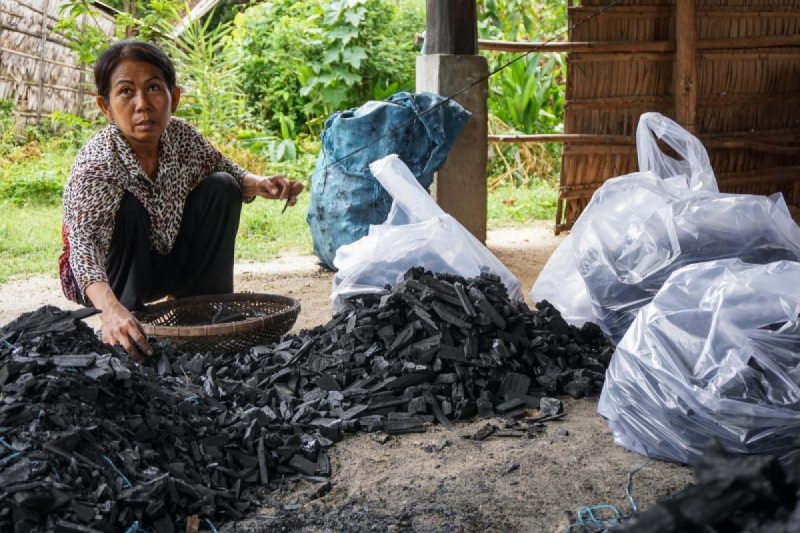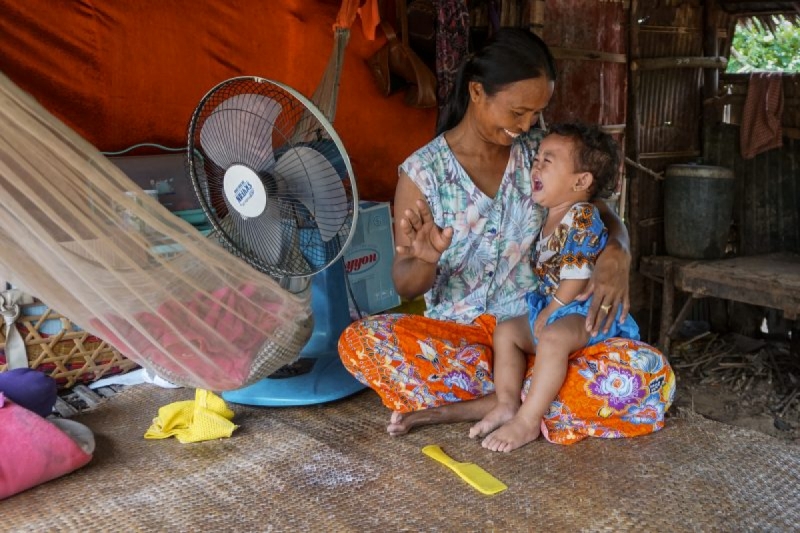




Takeo province – The first time Om Mat borrowed from a small-scale microfinance organization she bought 12 piglets. They were cheaper than cows, she says, at $25 each.
She made mosquito nets for them to sleep beneath, but it wasn’t enough to shield them from a heat wave at the beginning of the year. The piglets died within 10 weeks.
“It was so hot,” she said. “We couldn’t get them medicine fast enough.”
The second time Ms. Mat, 50, borrowed money, it was from a different microfinance institute (MFI). She used the $500 loan to buy one of her five children a motorbike to drive to work at a nearby garment factory.
The second lender was not forgiving about late payments, so when the pigs died, she began to fear the MFI would seize her house.
Ms. Mat again borrowed from the first MFI to repay the outstanding loans and cover the expenses of another child’s wedding.
She borrowed for a fourth time in May to buy more piglets. She was more cautious this time, only buying two. One died right away. The other grew to the size of a small dog before it, too, sickened in the heat and died.
The grandmother’s debts remain.
She owes just $7.50 for the two pigs, but has missed two payments for the motorbike and still owes $270. She says that her child at the garment factory is paying off that loan, sending small amounts each day: sometimes $0.50, sometimes a bit more.
She does not dare to borrow again.
“I’m afraid they’ll come to take it all back,” she said. “They’ll take my house, my moto; whatever I’ve bought, they’ll take it.”
Ms. Mat is one of many farmers across Cambodia who have borrowed from the country’s 78 microfinance institutions (MFIs) and registered rural money lenders to keep their families afloat during drought conditions that have devastated much of the country.
Earlier this year, Prime Minister Hun Sen described the drought as the worst natural disaster in a century and launched a weekslong relief campaign that saw a hundred military trucks carrying water to the worst affected provinces.
In a Facebook post last year, Mr. Hun Sen floated a few ideas to help victims of the drought, calling on banks and MFIs to defer farmers’ repayments, cut interest rates and refrain from seizing property of clients who failed to repay their loans on time.
This year’s rainfall has yet to refill water supplies and reverse the damage caused by two seasons of drought, and many farmers have only been driven deeper into debt as they struggle to raise crops, fish and livestock. As with Ms. Mat, some farmers have borrowed from multiple lenders to cover initial repayments, or have started missing payments altogether, caught in lending cycle.

“While that may seem like a large increase, the reality is that it’s gone from a very, very small number, to a slightly less small number, so people shouldn’t overreact to this,” he said in an email last month.
“The average arrears rate for the large microfinance institutions is less than 0.7 percent, which is much less than the bank sector in Cambodia, and is a low number on almost any global comparison.”
In absolute terms, lending to agricultural businesses has grown as Cambodia’s microfinance sector has continued to expand, but has shrunk from 42 percent of all lending to 35 percent over the past five years, as MFIs have shifted their portfolios in line with general economic changes, Mr. Higgins said.
“It is shrinking as a proportion of what they do, just as agriculture is shrinking as a proportion of the economy,” he said.
Agriculture loans are one of the “the highest risk sectors,” according to Adrian Merryman, chief executive of VisionFund, an MFI and subsidiary of child poverty NGO World Vision.
“Around 65 percent of VisionFund’s total loan portfolio is in the agriculture-related sector, therefore last year and this year’s extended drought has really affected our lending business and loan portfolio quality in the sector,” he said in an email. “In response to the challenges, we have gradually diversified our lending to other various sectors.”
Mr. Merryman said some farmers had transplanted crops several times after their first failed attempt, leading to higher expenses and greater losses.
“Consequently, they cannot repay their loan and may not even have sufficient income to sustain the family,” he said. “In some cases, drought-affected clients have approached more and more local money lenders or other financial institutions that have in turn pushed them into over-indebtedness.”
Despite mounting debts, VisionFund intends to keep lending to agricultural businesses, but wants to ensure that farmers are able to use the money to pull themselves out of debt. Customers are being taught better farming practices and are encouraged to diversify their own income streams, he said.
The microfinance sector has seen rapid expansion in the past decade, though warnings of a potential credit bubble have prompted measures to slow down lending. Loans stood at $3.26 billion at the end of the first six months of this year, an 11 percent increase from the end of last year, according to the Cambodia Microfinance Association.
Hout Ieng Tong, the association’s president, said the drought has had “no impact to the microfinance sector.”
“Every year we have a dry season,” he said during an interview last month. “The only exception this year is that the dry season is taking a bit longer.”
However, Mam Sroeun, a small-scale lender in Takeo province, has begun noticing a new problem. Five percent of his customers, he said, have packed up their lives and left their homes behind, having lost hope in the possibility of repaying their loans.
“Sometimes, we come to someone’s house to find that they have fled their house,” Mr. Sroeun said during an interview at a Takeo coffee shop last month.
“They take their wife and children with them, and leave everything else behind. Then we are forced to ask everyone around them: Where have they gone?”
Some say they are leaving to find work to repay him, while others just disappear.
“They leave and they go work in agribusinesses—in someone else’s fields—in far-off provinces, or some will go to Thailand,” he said. “They have nothing more to sell or a way to make money at home.”
Mr. Sroeun said this year has been particularly difficult for farmers as water supplies have dried up and hopes of growing enough rice to get through the year have faded.
“When they borrow, they do it hoping that their rice will grow and they will be able to pay us back,” he said. “When the farmers don’t have enough rice, they default. When it’s been a good year and they do have enough rice, the price in the market falls, and they have to sell it for cheap.”
Nearly all of Mr. Sroeun’s 300 customers are farmers. But most of them are not taking out loans for crops, having given up on making money from their fields and looking for other sources of income.
Some have found success. Almost a year ago, Samith Neath borrowed from Mr. Sroeun to start a charcoal business. It’s been a profitable enterprise so far, she says, though not a pleasant one.
“It’s not for rich people, or for beautiful people,” she said, gathering bricks beneath her house in Traing district. “My children are always dirty. The dust gets in their eyes and noses. They get sick.”
Ms. Neath used to farm rice on a patch of land near her house in Roneam commune, but gave it up to start the new business.
“You don’t make enough with the rice. Sometimes you don’t make anything,” she said.
Ms. Neath hasn’t missed a payment since she took out the $2,500 loan, selling up to $150 worth of charcoal in a day, though she’s unsure of her expenses. She now has a child studying in Phnom Penh, and has high hopes for the future.
“If you’re brave enough to borrow money, you struggle,” she said. “You struggle, and you work.”